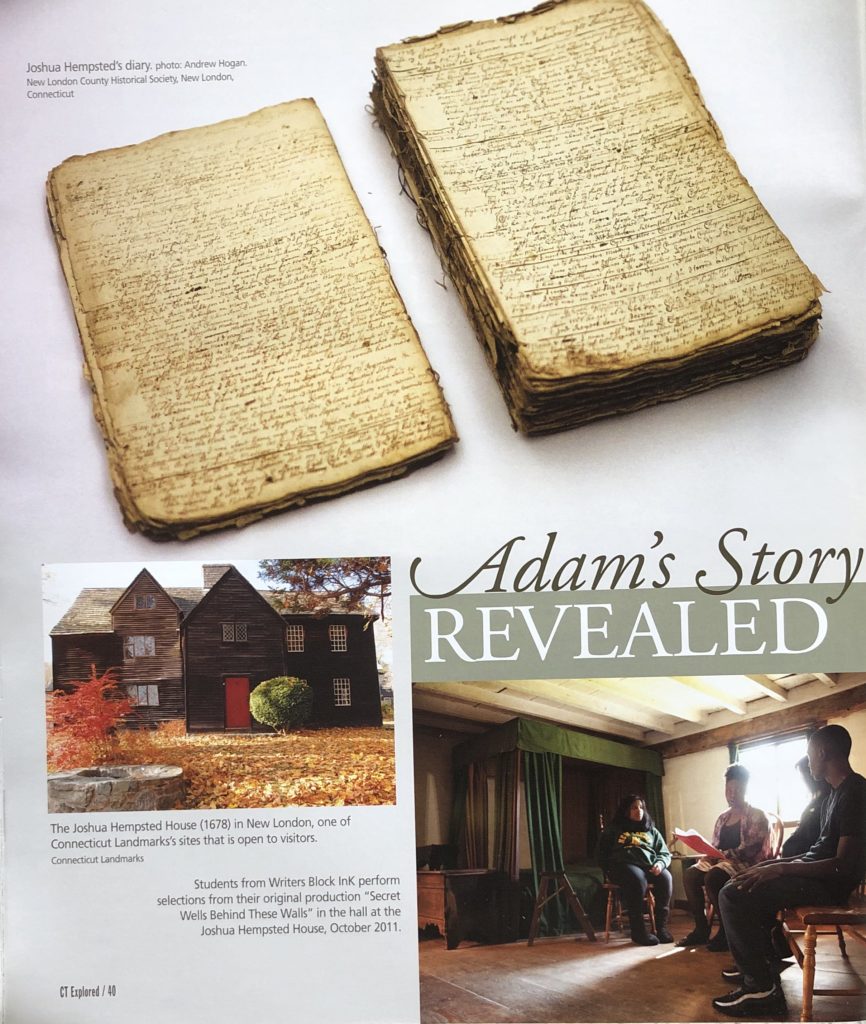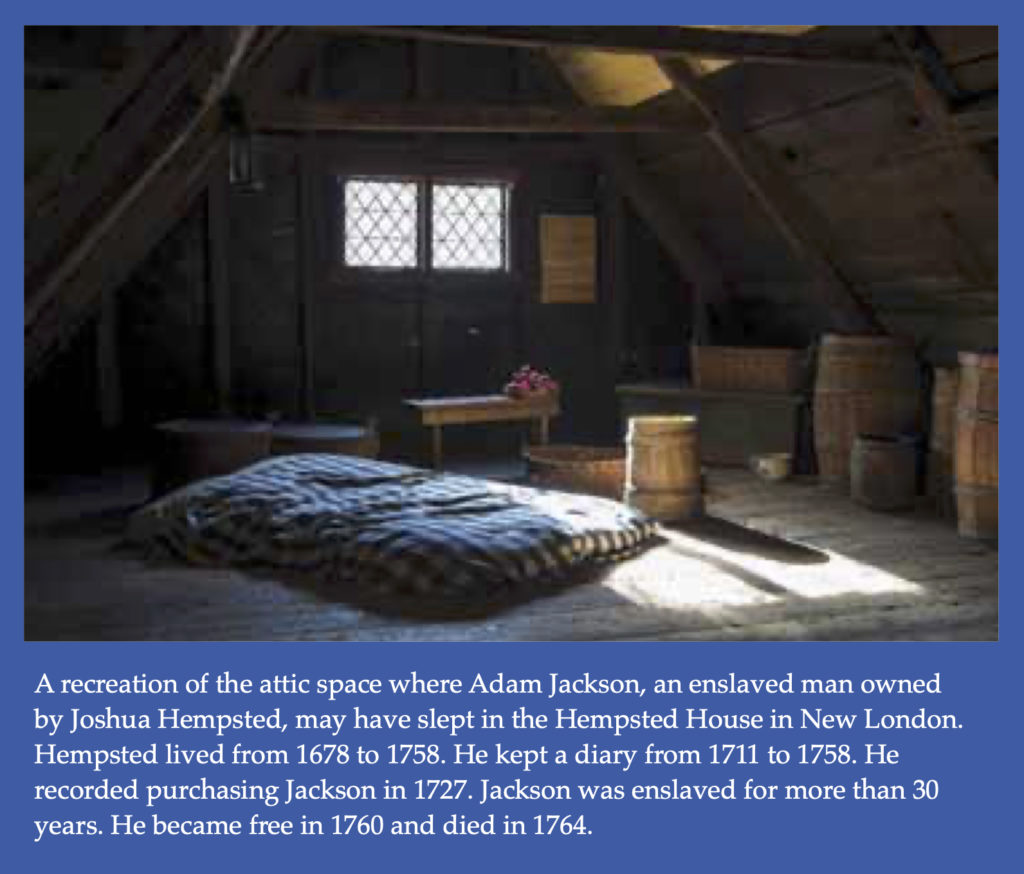(c) Connecticut Explored Inc. Spring 2013
Subscribe/Buy the Issue!
The Joshua Hempsted House is the oldest structure in New London to have survived the burning of the town by American traitor Benedict Arnold and his British troops during the American Revolutionary War [See “Benedict Arnold Turns and Burns New London,” Fall 2006.]. The house dates from 1678, nearly 100 years before the war for independence. It was built by Joshua Hempsted, whose father Robert received his land grant from the Connecticut colony in 1645, the year before New London was founded.
Remarkably, members of the family lived in the house for more than 250 years. It has been a museum (operated by Connecticut Landmarks) open to visitors, telling the story of the Hempsteds for more than 50 years. But another person lived there in the 18th century whose story is also important to understanding New London’s history. A new book, For Adam’s Sake by Allegra Di Boniventura (Liveright Publishing Corporation, a division of W.W. Norton & Company, 2013), is inspiring a project to tell his story to visitors.
What’s left of Joshua Hempsted’s diary begins when he was 33 and continues to the time of his death at age 80; earlier entries may have been lost. Whatever his motivation, his interests appear wide-ranging: He tracked his business transactions, along with information about important events in his and his neighbors’ lives. He recorded baptisms, marriages, and deaths, public events, war news, and the weather. Much information about his life as a shipwright, farmer, surveyor, justice of the peace, selectman, militia captain, business agent for the Winthrop family (descendants of the Connecticut colony’s first governor, John Winthrop the Younger, 1606 – 1676), and strong family man can be gleaned from his writing. The diary has been consulted widely by historians and remains one of the best sources of information about life in 18th-century New London.
But Hempsted’s diary also tells another story, that of the man he enslaved for nearly 30 years, Adam Jackson. Jackson was born around 1700 to Joan and John Adams and was a third-generation New Londoner. His parents and many of his siblings eventually gained their freedom. Adam Jackson did not become free until two years after Hempsted’s death in 1758.
Hempsted first mentioned Jackson in his diary in October 1725: “Thursd 14 Rain in ye morn. & yn fair. St. gone to J. Coits again. I was at home forn. Aftern I was Summoned to give Evidence about Black Adam.” The next entries come two years later when Joshua bought Jackson for £85 (emphasis added):
[September,] Thursd 21, [1727] fair & hot. In ye morning I went into Town & held a Court at ye Prison house. Sentenced Water Weebucks An Indian freeman to pay a fine of ten Shill & Charges 12s. 5s to me & 7s ye keeper & to make Satisfaction in Service. his Crime was breaking into Mr Winthrops house Tuesday night last. Tallman hath bot him for 15 days & to pay in a week—I was at Samll Foxes. I bot Adam for £85. I pd down & gave bond for 80 to be pd ths day 12 month & ye Interest. Wednsd 27 fair. Hodsol come fro L. Island. Adam is come ys morn. I was Sumond to attend ye Court to give Evidence in an Action between R. Christophers & Andrew Davise & went but came home Sick before night Ague & fever.
After Jackson was brought into the household Hempsted mentioned him regularly in his diary, most often discussing what he did that day as he worked for the Hempsteds and other people in town: Adam gathered corn, carted corn, cut and carted wood, thrashed and winnowed oats, carted dung and fetched mulch, mowed, plowed, cut a load of poles and mended a wheel, raked, fetched a lot of apples, made a stonewall, and killed swine.
Jackson’s life, and that of many in the Jackson family, is well documented. Di Bonaventura’s groundbreaking new book describes the complexity of the master/slave relationship and traces the intertwining stories of the Hempsteds and the Jacksons on the eve of the American Revolution.
Di Bonaventura’s 10 years of research and her forthcoming book have inspired museum staff to rethink the stories told at the Joshua Hempsted House. With support from the Institute of Museums and Library Services, Connecticut Landmarks will transform the way it presents the story of these two families to its visitors. Jackson’s life story has already inspired several Connecticut artists to create powerful new work: The Judy Dworin Performance Project presented In This Housein 2011, and the youth writing group Writers Block, InK presented Secret Wells Behind These Walls in 2011 and Wealth in Skin: Creative Historical Freedom Stories in 2012. The Hempsted House is uniquely poised to tell Adam Jackson’s story and those of other African-Americans in New London from the 17th century to the present day.
Cynthia Cormier was the education and historic sites operations manager for Connecticut Landmarks and a member of the Connecticut Explored editorial team.
Explore!
Read an excerpt from Hempsted’s diary about the death of Zeno, a 6 or 7 year old enslaved girl at our companion website, VentureSmithColonialCT.org.
Read about the Greenwich Historical Society’s work with the Slave Dwelling Project and its re-created space where enslaved people lived in the Bush-Holley House.
Read more stories about the African American experience in Connecticut on our TOPICS page.
VISIT
The Hempsted Houses
11 Hempstead Street, New London
Open May to October. For more information visit Ctlandmarks.org


